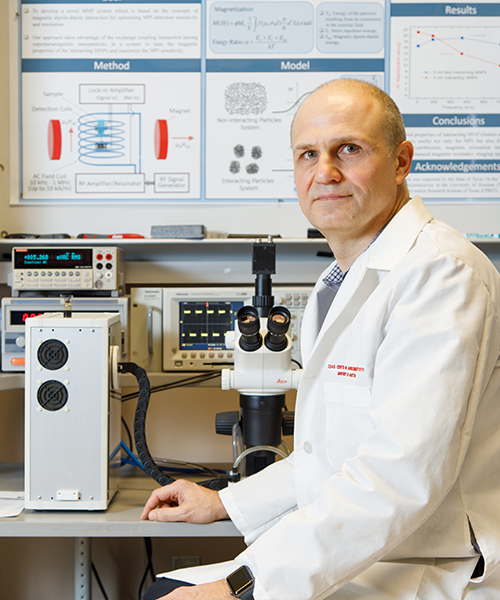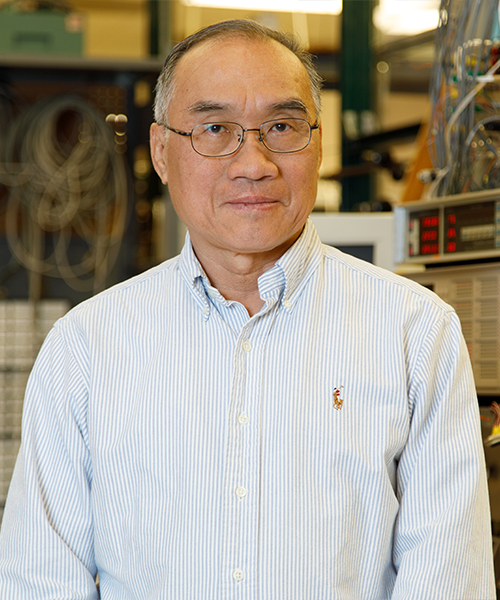TcSUH EventS
Special Seminar
Chemistry and Physics of Intermetallic Clathrates and Skutterudite-like Compounds
by: Dr. Yuri Grin
Date: Tuesday February 26, 2008
Time: 11:00 am – 12:00 pm
Location: Houston Science Center – Building 593 — Room 102
Overview
Crystal structures of intermetallic clathrates and skutterudite derivatives are formed by the 3D host frameworks with the differently sized filled or non-filled cages. Beside a variety of physical behaviours these compounds attracted the worldwide attention, e.g., as promising thermoelectric materials. Chemical bonding in clathrates and skutterudites is one of the key questions for the creation of the new materials of these classes. While the bonding in intermetallic clathrates may be sufficiently described by the Zintl concept with some modifications, the presence of transition metals in the filled skutterudites does not allow the straight forward description with simple electron counting. A more general description is possible with the new quantum chemical toolbox for bonding analysis in real space - electron localizability indicator [1]. Understanding of the chemical bonding allows to concept new preparation routes for synthesis of new representatives of this materials family. Especially, the (partial) control of the cage filling is achievable on this way [2]. This allows to prepare ‘empty’ clathrates, e.g., new modification of germanium [3]. Two new groups of filled skutterudites were successfully prepared. The iron-antimonides of the alkali metals NaFe4Sb12, KFe4Sb12 [4] and TlFe4Sb12 [5] represent the electron-poorest members of this family and reveal a wide spectrum of electronic properties. The novel family of REPt4Sb12 compounds shows i.e., superconductivity at relatively high temperatures [6]. [1] A. Leithe-Jasper et al. Phys. Rev. B. 2004 70 214418. [2] B. Bo?hme et al. J. Am. CHem. Soc. 2007 129 5348. [3] A. M. Guloy et al. Nature 2006 443 320-323. [4] W. Schnelle et al. 2008 submitted. [5] A. Leithe-Jasper et al. Phys. Rev. B. 2008 in press. [6] R. Gumeniuk et al. Phys. Rev. Lett. 2008 100 017002.
Back to TcSUH News & Events
Special Seminar
Magnetic Resonance Imaging: an Evolving Clinical Imaging Tool
by: Prof. Raja Muthupillai
Date: Friday February 22, 2008
Time: 12:00 pm – 1:00 pm
Location: Houston Science Center – Building 593 — Room 102
Overview
This lecture will focus on the various mechanisms through which contrast could be generated in Magnetic Resonance Images (MRI), and the clinical applications of MR. Among diagnostic imaging modalities, MRI is arguably the most versatile. Magnetic resonance imaging allows non-invasive evaluation of an array of tissue properties in vivo, e.g., tissue magnetic-resonance relaxation (anatomic imaging), metabolite distribution within tissue (spectroscopy), tissue micro-structure (diffusion), tissue micro-vascular flow (perfusion), tissue velocity, etc. This versatility has resulted in widespread use of MRI as a diagnostic imaging tool to assess pathology in patients. Recent technological advances have made it possible to use MR not just as diagnostic imaging modality, but also to use in conjunction with interventional, therapeutic procedures, e.g., MR guided focused ultrasound, and other MR guided interventions.
Back to TcSUH News & Events

Bi-Weekly Seminar
The Ultrasensitive SQUID-Based Sensing Applications for Biomedical Imaging and Diagnostics
Date: Friday February 15, 2008
Time: 12:00 pm – 1:00 pm
Location: Houston Science Center – Building 593 — Room 102
Overview
Superconducting QUantum Interference Device (SQUID) is the most sensitive and stable detector of magnetic flux available. The SQUID sensing provides the unmatched sensitivity and temporal resolution used for detection of the electromagnetic field perturbation associated with the neuronal currents in the brain, fetal cardiac activity, and the nuclear spin magnetization in ultra-low field NMR/MRI. In this presentation, I will summarize the current status of SQUID biomedical applications relevant to their present scientific and technological challenges, focusing on those applications that convey fundamental technological breakthroughs in corresponding biomedical fields. I will then describe our activities in the area of fetal cardiac monitoring, vulnerable plaque detection, cancer diagnostics and ultra-low field MR imaging. I will also present new research highlights from our recent clinical study in London aimed at developing a new ultrasensitive magnetic probe for detecting the spread of breast cancer.
Back to TcSUH News & Events

Bi-Weekly Seminar
The Unified Electronic Phase Diagram of High Tc
by: Prof. Pei Hor
Date: Friday February 01, 2008
Time: 12:00 pm – 1:00 pm
Location: Houston Science Center – Building 593 — Room 102
Overview
I will discuss the construction of a unified electronic phase diagram (UEPD) by analyzing various characteristic temperatures and energies of high-Tc cuprates using a dimensionless universal hole-doping concentration (pu). There are three converging characteristic temperatures (T*'s) and their corresponding energies (E*'s) as pu increases in the underdoped regime. T*'s and E*'s merge together with the Tc (pu) and 3.5kB Tc (pu) curves at pu ~ 1.1 in the overdoped regime, respectively. They finally go to zero at pu ~ 1.3. The UEPD follows an asymmetric half-bell-shaped Tc-curve in which Tc appears at pu ~ 0.4, reaches a maximum at pu~ 1, and rapidly goes to zero at pu ~1.3. The asymmetric UEPD curve is at odds with the well-known symmetric superconducting dome for La2-xSrxCuO4 in which two characteristic temperatures and energies that converge as pu increases and merge together when Tc goes to zero at pu ~ 1.6,. The unified phase diagram clearly shows that pseudogap is necessary for high temperature superconductivity. I will discuss some universal intrinsic properties of high- Tc that can be easily understood in terms of the UEPD.
Back to TcSUH News & Events

Special Seminar
Nanoscale Torque Measurements of F1 ATP-Synthase
Date: Monday January 07, 2008
Time: 3:00 pm – 4:00 pm
Location: Houston Science Center – Building 593 — Room 102
Overview
What is the efficiency of a biological molecular motor? The enzyme F1 ATP-synthase is a rotary motor/ generator found in a huge variety of organisms (plants, animals, and bacteria). Being a major player in cellular respiration, F1 has evolved to optimize efficiency. However, a thermodynamic measurement of F1?s efficiency has been difficult to obtain due to the 10 nanometer size of F1. To address this, we have constructed a new type of magnetic torque manipulator, involving the binding of specially designed nanoscale magnetic rods to glass surface anchored F1. By controlling the external magnetic field and observing the rod?s rotation via optical microscopy, kBT scale torque can be both applied and measured. Attaining this required overcoming non-trivial obstacles such as reducing thermal fluctuations of the rod magnetization, non-specific surface interactions, focus drift, and background magnetic field effects. Both mechanical energy production (ATP hydrolysis) and consumption (ATP synthesis) will be discussed.
Back to TcSUH News & Events
